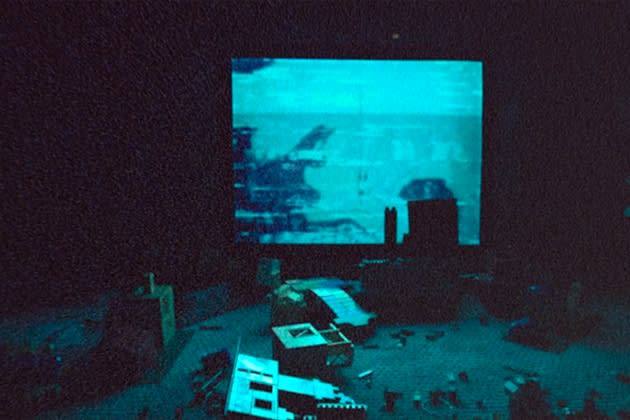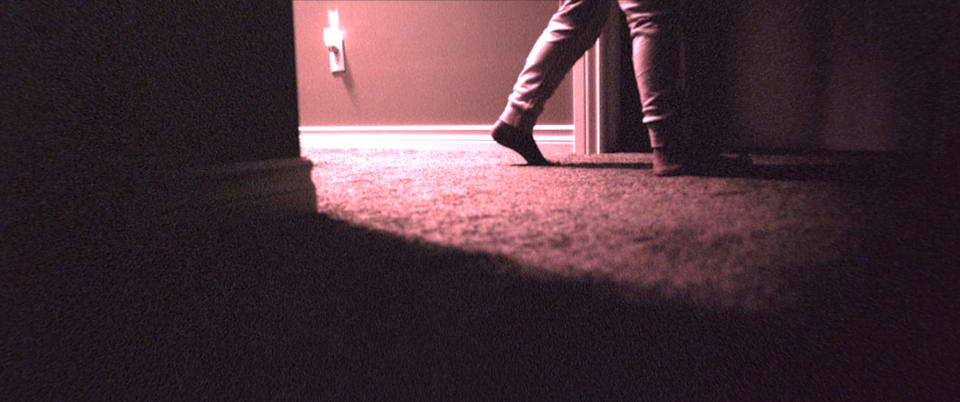Inside ‘Skinamarink’: The $15,000 Horror Movie That’s Captivated TikTok

The cardinal rule of bedtime is simple: Don’t look under the bed. Everybody knows this. Amoebas know this. Yet Kaylee, one of the two young kids in Kyle Edward Ball’s low-budget Canadian horror flick Skinamarink, does it anyway. Worse, she does so after a voice in the dark instructs her to. A voice in the dark! This is after her father seems to disappear from their house, leaving her and her brother, Kevin, alone to face the shadows. It’s after a sleepwalking incident apparently leaves her injured. It’s after the windows and doors of the house seem to disappear, flickering out of existence. Which is all to say that a stranger’s voice telling Kaylee to “Come here” and “Look under the bed” and, later, “Close your eyes” is not really a voice to be heeded.
But she looks under the bed anyway. Rather, we do, seeing it all play out in a long, slow, cautious motion witnessed from Kaylee’s direct point of view. We are along for the ride as she dips down in the dark of her parents’ room, right next to a maybe-person, who’s maybe-sitting on the edge of that bed, and who will also maybe-disappear (someone else takes their place) — all because a stranger’s voice beckoned Kaylee here to do exactly this, reasons unknown. In another movie, you’d scream at the screen; you’d call this four-year-old child an idiot, then sop up this auspicious start to her scream queen era. But Skinamarink’s effect is decidedly more venomous than that. Venomous in the sense that if the movie is working for you (and there is no guarantee that it will), there’s a chance you’ll be too immobilized to talk back at the screen, too busy being lulled into the movie’s quiet cadence of cutting, oddly mundane, wait-and-see terror. The satisfaction is not in building toward explanation and release, but in making peace with the chaos of an evil that has no explanation, that can, as it tells Kevin late in the movie, “do anything.” That is the movie’s sublime trick: moseying along at the evil’s pace, as if it were really that unknown force, not Ball, who directed the movie.
More from Rolling Stone
A Hatchet-Wielding Hitchhiker Went Viral. Then He Killed Someone.
'M3GAN' Is the Killer-Robot Blair Waldorf You Didn't Know You Needed
Stare at anything for too long and it starts to move. That’s what watching Skinamarink is like: You’re watching the familiar suddenly jolt alive with new, uncanny energy. Skinamarink is not a fleshed-out, robust narrative adventure. It is a slim experiment. Ball has said that he took inspiration from a common dream he noticed among people commenting on his YouTube channel, @BitesizedNightmares: of waking up, as a kid, and realizing you’re alone in the house with a monster. Skinamarink is frankly just a feature-length extension of what Ball’s YouTube channel already does. There, he collects nightmares from online comments and makes them into 3-4 minute short films. Here, he gives those nightmares a home. Skinamarink is set in 1995, and that is all we know about the setting. The style adds something here. A grainy filter over the images and a constant pop on the soundtrack, emulating celluloid film, both mark the movie as some unmistakable object from the past. It would have to be — half of its effect stems from the torture of an analog world, with fewer screens and sources of light and means of connecting to the outside. There’s a genuine sense of being trapped.
The movie cost $15,000 to make and unabashedly belongs to that school of microbudget filmmaking that can morph limited resources into a fully-formed aesthetic — an approach that has always suited horror well. Especially cult horror. Skinamarink’s minimalism has that integrity. Regardless of the budget, the style has enough intention that it is hard to imagine the movie wanting to be anything but what it is.
You can feel the rules of Ball’s aesthetic at play from the start. We don’t see faces. The house may as well have no exterior: We never see it, never go outside. Sounds usually point to action offscreen. We never see anyone talking. Many of its shots are static and compositionally off-kilter, a mix of low-angle views of walls, ceilings, and shadows, or slow pans across surfaces, or occasional angles on the childrens’ feet in their jammies as they wander, or of isolated groups of objects, like Legos or an always-blaring television that’s playing cartoons. It can feel a little like watching CCTV of a house in which the only one awake is the house itself. Much of the time, nothing happens within a shot — until it does. A flickering, or a sound. The kids’ feet (you assume) shuffling along the carpet. That voice in the dark. When we follow the kids on tours of the house, we experience their journeys through first-person POVs, often with a flashlight in tow, sometimes with dreamy crossfades collapsing time and space and other times with the flashlight clicking on and off, as if daring something to emerge in front of us.
You can’t blame Kaylee for daring to look under the bed, really. Because what’s even happening, here? Skinamarink isn’t a mystery, exactly, insofar as mysteries are problems that someone sets out to solve. Ball is more interested in using the basics — including our senses — against us. It feels less interested in being a “horror movie” than in being a movie-length reminder of what we’re so afraid of to begin with. No one loves to hear whispers in the dark, or thuds from hidden rooms. Everyone carries the burden of some irrational fear. What we cannot see and do not know is often more terrifying than what’s right in front of us — horror movies depend on this. Skinamarink stands out because its premise so depends on the familiar. The movie was shot in Ball’s childhood home, and you can tell. He shoots these hallways and rooms with an eye for their shadows that feels too eerie for it not to be intimate. He’s made a movie in which we see a living room approached from angles that you’d only know if you’d grown up in them — ways of seeing a room that no one ever actually intends to catch. What feels familiar to him feels that much more familiar to us. We travel these halls enough, in the dark no less, to feel like we know them. Violation of that space almost starts to feel personal.

There is a chance that you, a scoundrel, have seen Skinamarink already. The movie’s official theatrical release is this week, but it had the mixed fortune of being leaked last year. Mixed, that is, because it may have resulted in awkward expectations. Millions of eyes on TikTok and Twitter caught glimpses of Skinamarink’s cathode ray-lit interiors and creepily memeable closed-captioning (picture a shot of a nightmare-blue blur overlaid with dialogue, spoken from the shadows, that says “I can do anything.”) It suits a movie like this, whose mysterious nothing-blur aesthetic can fully entice us based on only a few quick clips and still photos.
But going viral comes with the implied promise of wide appeal. There are already complaints that the movie is too slow, too artistic. The movie is very still — like the night in which it’s set. One of the best things about it is its controlled discretion, its willingness to resist our eagerness for sensational thrills or for the familiar rhythm of an amped-up climax. Instead, we’re given an ending that tears the threadbare fabric of the movie apart even more — quiet horror at its finest. Skinamarink isn’t scary because of what it depicts. It’s scary because it already knows that our imagination will do half of the work.
Best of Rolling Stone

